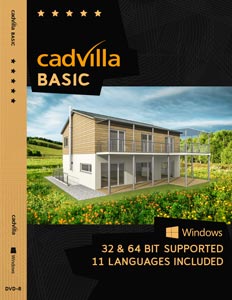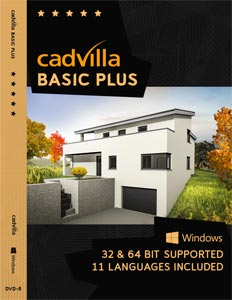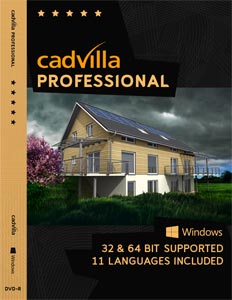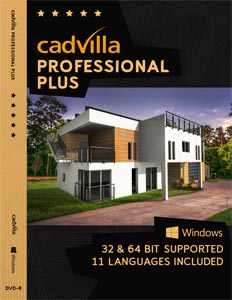You want to build a house, but do not know yet how and what to look for before you start the actual floor plan? Here we have put together the most important points in the form of a checklist.
Requirements of house planning for house builders
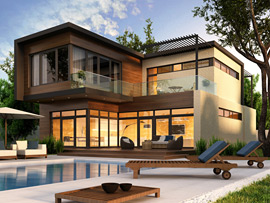 When you start designing your dream house in most cases the initial point will be the desired and maximum possible living space. Further points such as the house layout, the desired house type, the use of building elements and also the selection of building materials are your next relevant steps.
When you start designing your dream house in most cases the initial point will be the desired and maximum possible living space. Further points such as the house layout, the desired house type, the use of building elements and also the selection of building materials are your next relevant steps.
The overview of our house planner will give you some ideas that should be defined and decided before you start to design your own four walls.
Step 1: Find the right property and determine the maximum possible living space
Do you know how much living space you need and do you already have a nice property for your dream house? There are several points that have to be considered concerning the calculation of living space. The maximum possible floor space on a property influences the house planning and is limited by the requirements of the land-use plan (e.g. coverage ratio, floor space ratio). You will find information in our article about the values of land-use planning that influences living space.
House layouts
Building elements
Step 2: Define your house layout
Residential houses are offered in many different layouts. However, the different house layouts influence not only appearance but also the price of your dream house.
Every house layout provides advantages but also disadvantages. We will show you how the most common house layouts differ from each other.
Single family house
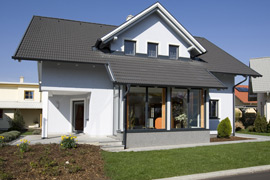
The single family house is a house for one family. It is positioned detached on a property and is therefore separated from the neighbors. The single family house is neither structurally nor constructively connected to one of the adjacent buildings.
A single family house has its own garden and in most of cases consists of a ground floor and an upper floor. In some cases it also has an extended attic floor (dormers) and possibly a basement. Building extensions such as a garage or a carport are usually part of the plan of a single family house.
A special feature of single family houses built on a slope is that they have various offset levels (split levels) on one floor.
Due to the fact that single family houses are not connected to other buildings, the building costs are typically higher than the costs of building a row house or tract houses. However, using triple glazed windows the house owner can save a lot of the regular costs (operating costs).
Single family houses are offered as solid masonry homes, prefabricated houses, bare-bone houses and wooden houses.
Multi family house – the house for several families
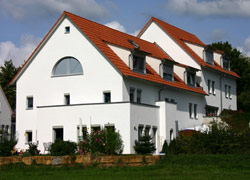 In contrast to a single family house, a multi-family house is designed for multiple families. It is positioned detached on a property and is neither from the structural nor from the constructive standpoint connected with one of the adjacent building.
In contrast to a single family house, a multi-family house is designed for multiple families. It is positioned detached on a property and is neither from the structural nor from the constructive standpoint connected with one of the adjacent building.
The multi-family house usually has its own garden and typically consists of multiple floors with secluded living areas. The multi-family house is often used together with friends or relatives.
Families that have their own grandparents or friends living in the same house can share child care, the care and cleansing of the house and maybe also cooking.
Multi-family houses are usually offered as solid masonry homes, prefabricated house and bare-bone houses. You can find additional articles helping you design your house in our guide for house builders.
Row House
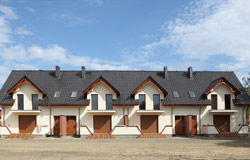 A row house is a two to three floor single family house that forms an alignment with other houses having the same appearance and being adjoined to each other (mostly alongside a building line). This alignment is for example arranged parallel to a road.
A row house is a two to three floor single family house that forms an alignment with other houses having the same appearance and being adjoined to each other (mostly alongside a building line). This alignment is for example arranged parallel to a road.
Most row houses are narrow and deep, the floors often include split levels in order to create a better spatial perception. Regarding the centered row houses, the walls adjoined to the adjacent row houses are not just constructed as a pure fire wall (partially with sound insulation) and they do not need thermal insulation.
An additional sight protection for the garden to the adjoining property is often desired. The size of the garden is limited.
A row house is cheaper than a single family house because the adjoining walls do not have to be insulated making efficient use of the property. Due to the adjoining walls the energy consumption is usually lower.
Duplex House
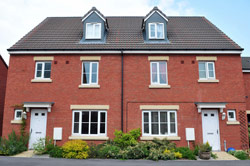 The duplex house is a mixture between a single family house and a row house, and it is intended for two families. It consists of two households that are typically connected mirror-inverted with each other with a dividing wall. The dividing wall requires fire protection insulation and sound protection insulation. A thermal protection for the dividing wall is not required.
The duplex house is a mixture between a single family house and a row house, and it is intended for two families. It consists of two households that are typically connected mirror-inverted with each other with a dividing wall. The dividing wall requires fire protection insulation and sound protection insulation. A thermal protection for the dividing wall is not required.
A duplex house always consists of two separate entrances and two separate staircases. From the outside the two (mirror-inverted) parts of the house resemble each other. Inside the duplex house the room layout can be designed freely.
In most cases a duplex house is surrounded by its own garden and consists of minimum one ground floor and one upper floor. Houses often have an extended attic floor which makes sense from the economic efficiency standpoint.
A duplex house costs less than a single family house considering each half of the house but costs more than a row house. The required property can be used efficiently, it requires less building materials, and the energy consumption is slightly lower than a single -family house because of the common wall.
Duplex houses are usually offered as solid masonry homes, prefabricated houses and bare-bone houses.
Bungalow – a house with high standards
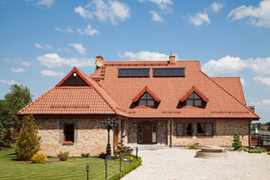 A bungalow is a house that consists only of one floor. Families with small children often prefer a bungalow because the risk of accidents because gaps in the stairs do not exist; the living spaces are clearly visible and are easy to clean.
A bungalow is a house that consists only of one floor. Families with small children often prefer a bungalow because the risk of accidents because gaps in the stairs do not exist; the living spaces are clearly visible and are easy to clean.
Due to the fact that there are no internal stairs to a second floor, the bungalow is also an ideal way of living for disabled people. The entire planning of individual rooms can be barrier-free. There is little need to walk up the stairs to a second floor. An elevator would be an alternative for the stairs.
In most cases a bungalow has a flat roof, gable end roof or hipped end roof, A bungalow is normally detached on a property and is neither from the structural or constructive standpoint connected with one of the adjacent buildings.
You can find bungalows frequently on properties that have more than enough base area.
Bungalows can be offered as solid masonry homes, prefabricated houses, bare-bone houses or wooden houses.
House layouts
Building elements
Step 3: Define house type – not just a question of cost
A house can be built in different ways. What are the advantages, what are the disadvantages? You already have an idea of your dream house but would you like to go deeper into the details of house planning? Then you are in the right place here. We will show you the most common house types including their differences in the building technique.
Prefabricated house – The house from the catalog
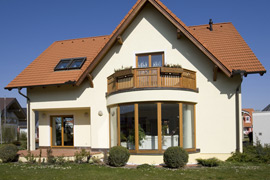 Compared to conventional building techniques, the prefabricated house offers several advantages. Prefabricated houses are produced in production halls as component parts, and then assembled and constructed onsite.
Compared to conventional building techniques, the prefabricated house offers several advantages. Prefabricated houses are produced in production halls as component parts, and then assembled and constructed onsite.
A conventional solid masonry home requires up to one year being really dry and developing a comfortable indoor climate. However, the prefabricated components of a prefabricated house are already delivered to the construction site in a dry condition and are assembled in just a few days. As a result you save not only a considerable time and energy but also money.
Many manufacturers of prefabricated houses already use modern CAD software systems such as cadvilla in combination with modern production plants. Now, in case of a massive building technique, the floor plan of a prefabricated house can be designed according to your individual needs. In case of a construction made of wood, sometimes raster dimensions must be observed. The style of a house can be modern or rustic, and can be selected freely according to your own taste.
Prefabricated houses are offered in a wide variety of materials and material combinations. The solid prefabricated house may consist of concrete, brick, lime-sandstone, lightweight concrete, expanded concrete or the like. Lighter construction methods for the prefabricated house consist of prefabricated wood, wood composite or wood stand construction.
In addition to the conventional building technique, single family houses, multi-family houses, row houses, duplex houses and bungalows are also offered as prefabricated houses.
Bare-bones House – reduces the costs of building a house
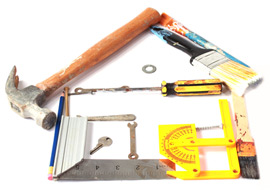 The bare-bones house bare-bones house (also called a house that you participate in building) is a special type of prefabricated house which prefab manufacturers offer. Prefabricated houses are thermally insulated from the outside and rain-proof. The interior finishing of a prefabricated house is carried out by the house builder completely or partially by himself (design and execution).
The bare-bones house bare-bones house (also called a house that you participate in building) is a special type of prefabricated house which prefab manufacturers offer. Prefabricated houses are thermally insulated from the outside and rain-proof. The interior finishing of a prefabricated house is carried out by the house builder completely or partially by himself (design and execution).
The house builder can choose between various options on different levels regarding the development of his house.
The bare-bones house typically includes the following:
- Thermally insulated and fully plastered external walls
- The front door and the patio door
- Preinstalled windows including the roller shutters
- Basement ceilings and floor ceilings
- Solid basement stairs and solid stairs to other floors
- Fully roofed roof with a finished soffit (thermal insulation optional)
- Empty conduits in the walls for electrical installation
- Empty conduits for water, waste water, heating and gas
- Balcony with a handrail and water drain-off
The interior finishing by personal contribution consists of the following among other things:
- Installation and connection of the heating system
- Electrical installation
- Laying the screed
- Laying the floor heating
- Laying the impact sound insulation
- Laying the parquet
- Laying the tiles in basement, bathroom, kitchen and vestibule areas
Solid masonary house – value stable house with many advantages
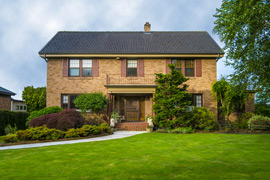 The solid masonry house is traditionally built with building bricks stone on stone. The used building bricks typically consist of red bricks (consisting of clayey loam), sand-lime brick or concrete stone.
The solid masonry house is traditionally built with building bricks stone on stone. The used building bricks typically consist of red bricks (consisting of clayey loam), sand-lime brick or concrete stone.
These building bricks have good insulation properties, they provide good sound insulation and they are good heat accumulators and very robust. A solid masonry home also has better properties regarding fire resistance compared to a house made of wood.
Houses built with solid bricks provide a comfortable and healthy indoor climate and typically have a higher resale price when resold. Due to the solid building technique, solid masonry homes outlast many generations and have extensions added.
It is relatively easy to execute bigger extension work. You can quickly perform a wall penetration – if it is feasible from the statics standpoint.
Single family houses, multi-family houses, row houses, duplex houses and bungalows are often built as solid masonry homes.
Low-energy House – save energy and money on running costs
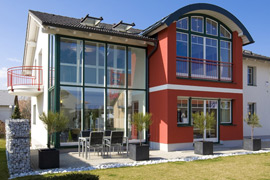 A low-energy house (also passive house) optimizes your energy prices. Compared to conventional buildings, the energy costs are reduced by 80% on average
A low-energy house (also passive house) optimizes your energy prices. Compared to conventional buildings, the energy costs are reduced by 80% on average
The heat requirement of a low-energy house refers to a room temperature of 20° C and must not exceed the value of 15 kilowatt-hour/m2. This means at the same time that you manage with 1.5 liter fuel oil/m² per year with a room temperature of 20°C and an assumed 15 KWh/m².
The following measures lead to a reduction of the energy costs:
- Ideal thermal insulation
- Ideal tightness
- Ventilating system for ideal gasper supply considering a constant room temperature (makes aeration unnecessary)
- Use of solar collectors
- Triple glazed energy-preservation windows
- Use of a heat pump
Due to an ideal thermal insulation, wall thicknesses up to 47 cm can be reached. The high thermal insulation, the switch-off of thermal bridges, the use of solar collectors and heat pumps as well as the use of energy-preservation windows minimize the monthly energy demand for warm water and make the use of additional heating unnecessary.
The ventilation system is equipped with heat recovery and exchanges the entire indoor air every 20-30 minutes. This way you can reach a comfortable and healthy indoor climate. If the ventilation system is also equipped with a pollen filter, this reduces problems for people allergic against pollen to a minimum.
A passive house is more expensive to purchase than a conventional house. Due to the thick thermally insulated walls and with the same constructed space around the building, there is a larger gross floor area predetermined by the land-use plan.
Single family houses and multi-family houses are often constructed as passive houses.
Wooden house – Pleasant room climate and ecologically sustainable building
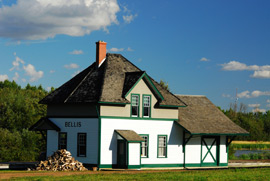 The wooden house is built with modern and natural building wood materials. Wood materials communicate warmth, peace and a feeling of security, while providing a comfortable indoor climate.
The wooden house is built with modern and natural building wood materials. Wood materials communicate warmth, peace and a feeling of security, while providing a comfortable indoor climate.
Wood is a renewable raw material and is suitable for building a residential house, a single-family house, and even an entire hotel. Wood requires no drying times (because it can be predryed) as opposed to a solid masonry homes, and therefore facilitates very short construction times.
Wooden houses often require a little bit more care and maintenance than solid masonry homes.
In America and Scandinavia wooden houses have been built for a long time, and also in Central Europe they have become more and more popular as family houses and bungalows.
House layouts
Building elements
Step 4: Definition of building elements – components for different requirements
A house consists of various components. We will show you the differences in the individual components and whereupon you should take care.
Roof and roof shapes – the architecture decides
The roof forms the upper limitation of a building. We show you the structure of the roof and the different roof shapes here.
Dormers
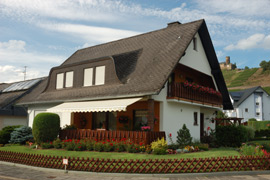 A dormer is a roof structure on an inclined roof area.
A dormer is a roof structure on an inclined roof area.
There are dormers of different shapes. Below you will find a list of the most important dormer types:
 standing dormer (also called gable dormer)
standing dormer (also called gable dormer) swept dormer
swept dormer hipped dormer
hipped dormer triangular dormer (also called dwarf gables)
triangular dormer (also called dwarf gables) trapezoidal dormer
trapezoidal dormer arched dormer (also called barrel dormer)
arched dormer (also called barrel dormer) eyebrow dormer
eyebrow dormer
Dormers are commonly used for extending the living space in the attic floor. A dormer facilitates a decent ceiling height in the dormer area and extends the living space. Similar to a roof window, dormers provide a l great deal of light to the roof space and thus creates a home-like atmosphere.
There are dormers with windows but also with doors. Dormers with doors mostly lead to a roof terraces in form of an opening in the roof or on a small balcony.
Windows and window shapes
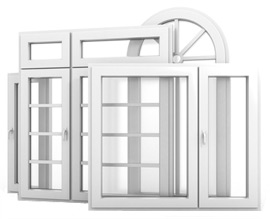 A modern window consists of a frame or at least a window sash with corresponding window fillings. Besides various light-transmissive glass types, the window filling for instance also consists of inserted sash bars.
A modern window consists of a frame or at least a window sash with corresponding window fillings. Besides various light-transmissive glass types, the window filling for instance also consists of inserted sash bars.
The most frequent window shapes
There are modern windows in various shapes available for your house planning. We distinguish roughly between a
- plain window (window with one sash)
- window with two sashes
- window with multiple sashes
- window with geometric shapes (round window, triangle window, trapezoidal window)
- window with a round arch
- pointed arch window
- semi-circle window
- window with fanligh
- window with sublight
Multiple glazing – sound insulation, thermal insulation, light transmittance
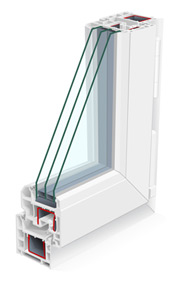 The glazing of a window is crucial for sound and thermal insulation. The simplest type of glazing is single glazing. Today modern windows have multiple glazing with insulating glass.
The glazing of a window is crucial for sound and thermal insulation. The simplest type of glazing is single glazing. Today modern windows have multiple glazing with insulating glass.
In case of multiple glazing (currently triple glazing) there is a cavity between the single window panes which is hermetically sealed and serves as thermal insulation. The cavity is filled with the noble gas argon or krypton. The thickness of each window pane in case of multiple glazing is crucial for the sound insulation (compound glass). The light transmittance of the entire glass filling decreases due to multiple glazing and due to the thickness of each single window pane. (Standard value for a regular triple glazing: >70%)
The resistance class determines the protection against burglary
The thickness and the structure of the window pane also influence the resistance class against burglary. In order to increase the resistance class of a window, however, burglary-resistant window-hardware must be used. The window-hardware should be secured against being lifted out (e.g. with a mushroom head fitting). The window should be lockable on each edge of the window once or twice with a window-hardware. Another way to increase the resistance class is the use of burglary-resistant roller shutter systems.
Stairs
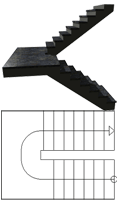
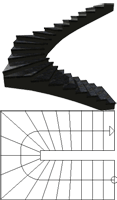 Stairs consists of multiple steps and connect the floors in a house with each other (interfloor staircase). Stairs in multistory buildings are usually extended by an electric elevator, and the actual stairs are often placed in an own staircase). In addition to their actual purpose, the stairs in a staircase often serve as an emergency staircase.
Stairs consists of multiple steps and connect the floors in a house with each other (interfloor staircase). Stairs in multistory buildings are usually extended by an electric elevator, and the actual stairs are often placed in an own staircase). In addition to their actual purpose, the stairs in a staircase often serve as an emergency staircase.
With the external area it is important that the external stairs are weather-resistant and are equipped with slip resistant surfaces.
The most common types of staircases in a residential house are:
- Straight staircase
- Quarter-turn staircase
- Quarter-turn staircase with landing (in the beginning, in the end or in between the stair)
- Half turn staircase (u-staircase)
- Half turn staircase with landing (half-landing, stairs with landing)
- Spiral staircase
Stairs are available in a solid and a light design. A staircase made of concrete is an example for solid stairs. A staircase made of wooden stairs or glass elements is an example for a light design.
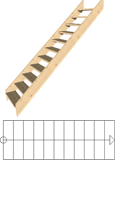
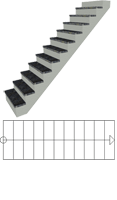
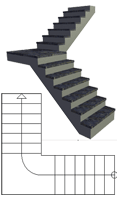
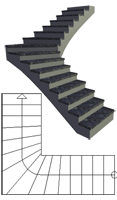
Doors (Front doors, basement doors, internal doors and patio doors)
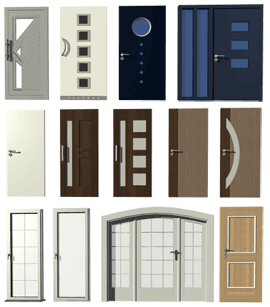 Doors connect different areas with each other. An external door connects the external area with the living space, an internal door connects different rooms and areas of a room with each other and a patio door connects the garden, the balcony and the patio with the living space.
Doors connect different areas with each other. An external door connects the external area with the living space, an internal door connects different rooms and areas of a room with each other and a patio door connects the garden, the balcony and the patio with the living space.
The most important elements of a standard door are the door leaf (describes the movable part of a door), the door frame and the door hardware (consisting of hinges, door handle and door lock)
Properties of a door is determined by the requirements
A front door of a house or a flat should mainly provide good sound insulation and should be burglary-proof (please consider the resistance class). You should also never neglect the thermal insulation of a front door. The front door constructed in a solid way, should have a minimum passage width of 90cm and should be integrated visually well in the entrance area. A front door should be made of materials that are weather-resistant.
When house planning, the entrance area with the vestibule area should offer the possibility to (re)design it to be handicapped accessible and therefore should be designed more spaciously.
There are similar requirements of patio doors and balcony doors as there of front doors. The door leaf is mostly filled with glass elements and sash bars (adapted to the windows). The patio door as well as the balcony door is mostly constructed as a simple door, double-wing door or as a door with a sliding element.
The basement door is typically constructed in a solid way, weather-resistant, burglary-proof, and provides good sound insulation and insulation protection.
The internal doors are available in different designs. In addition to the simple standard door, there are also double-wing doors, sliding doors, folding doors and many more. The used type of door depends on the type of use, the used materials depends on the personal taste.
Materials of doors
Doors are available in different materials depending on the purpose of use. There are doors made of wood, doors made of steel, doors made of aluminum, doors made of glass, doors made of plastic material and doors made of a combination of the mentioned materials.
Step 5: The right house plan software
In order to be able to draw a floor plan you will need a program for house planning that provides everything you need to hand over your ideas to an architect and the authorities (for the building application). In addition, the software should of course have an ideal price/performance ratio. You will find the most important selection criteria that you should consider when selecting a program for house planning in the following article.
Design your dream house on your own with our professional 3D house plan software

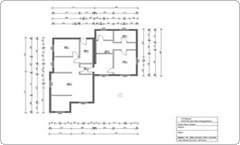
Whether you prefer an individual house or a prefabricated house – nearly every wish can be fulfilled with our house plan software cadvilla professional. An automatic quantity survey and a calculation of residential floor area for designing a house are also included in cadvilla professional. The CAD program cadvilla professional is the ideal software for planning your house on your own and for quickly gaining a first insight into 3D technology.
You can take over and process existing designs in 2D DXF/DWG format into 3D when planning your house.

